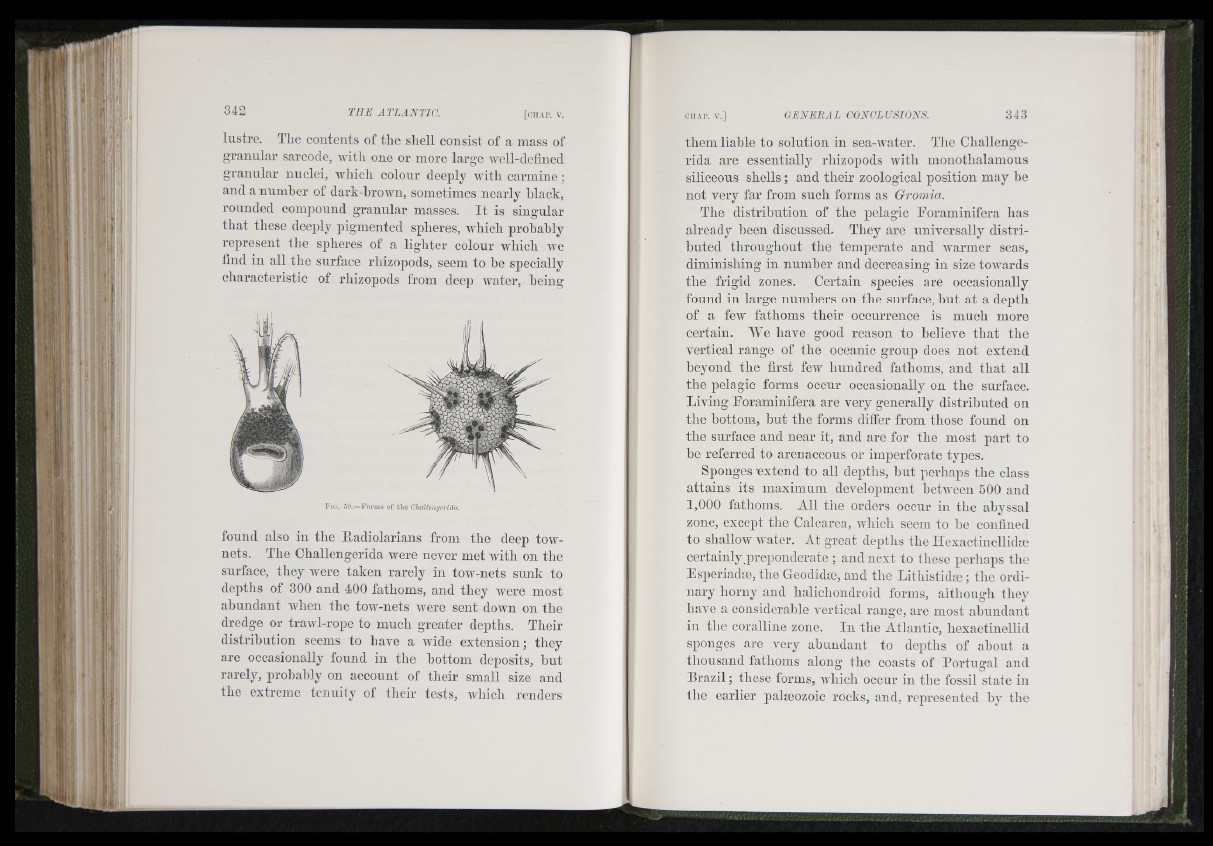
!. <;
! \ I i ’ :
I
;i i
‘ 1
/'
(i ■'
' I
lustre. The contents of the shell consist of a mass of
granular sarcode, Avitli one or more large well-defined
granular nuclei, wliicli colour deeply with carmine;
and a nnmber of dark-hrown, sometimes nearly hlack,
rounded compound granular masses. It is singular
that these deeply pigmented spheres, which probably
represent tbe spheres of a lighter colour which aa'c
find in all the surface rhizojiods, seem to he specially
characteristic of rliizopods from deep water, heing
Fru. 5!!. —Forms of the Challengerida.
found also in the Radiolarians from the deep tow-
nets. The Challengerida were never met with on the
surface, they Avere taken rarely in tow-nets sunk to
depths of 300 and 400 fathoms, and they were most
abundant Avhen the tow-nets Avere sent doAvn on the
dredge or traAAd-rope to much greater depths. Their
distribution seems to have a wide extension; they
are occasionally found in the hottom deposits, hut
rarely, probably on account of their small size and
the extreme tenuity of their tests, AA'hich renders
them liable to solution in sea-water. Tlie Challengerida
are essentially rliizopods Avitb monotbalamons
siliceous shells; and their zoological position may he
not very far from such forms as G r om ia .
The distribution of tbe pelagic Eoraminifera lias
already been discussed. Tbey are universally distributed
tbrougbout tbe temperate and AA'armer seas,
diminisbing in number and decreasing in size toAvards
tbe frigid zones. Certain species are occasionally
found in large numbers on the surface, but at a depth
of a few fathoms their occurrence is much more
certain. "VYe have good reason to believe th a t the
vertical range of the oceanic group does not extend
beyond the first few hundred fathoms, and th a t all
the pelagic forms occur occasionally on the surface.
Living Loraminifera are very generally distributed on
the hottom, hut the forms differ from those found on
the surface and near it, and are for the most part to
he referred to arenaceous or imperforate types.
Sponges -extend to all depths, hut perhaps the class
attains its maximum development betAveen 500 and
1,000 fathoms. All the orders occur in tbe abyssal
zone, except tbe Calcarea, which seem to be confined
to shallow Avater. At great depths tbe Hexactinellidm
certainly preponderate ; and next to tbese perbaps tbe
Esperiadge, tbe Geodidge, and the Litiiistidge; the ordinary
horny and halichondroid forms, although they
have a considerable vertical range, are most ahundant
in the coralline zone. In the Atlantic, hexactinellid
sponges are very ahundant to depths of ahont a
thousand fathoms along the coasts of Portimal and
Erazil; tliese forms, Avliicli occur iu tlie fossil state iu
the earlier palgeozoic rocks, and, represented hy the